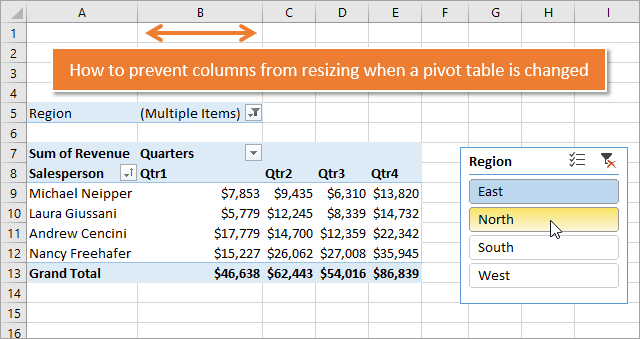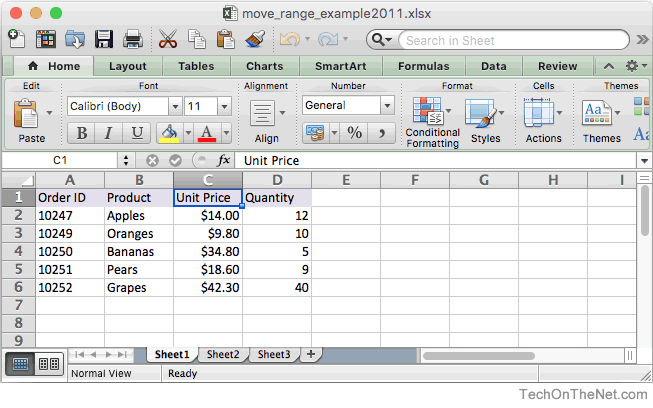
- Moving columns in excel for mac 2016 for mac#
- Moving columns in excel for mac 2016 download#
- Moving columns in excel for mac 2016 windows#
Click the intersection of rows and columns -> the whole worksheet is highlighted:Ībove is a detailed guide for manipulating blocks in Excel 2013. Click the letter above the column you want to move.
Moving columns in excel for mac 2016 windows#
On a Mac, the command key () can be used instead of the. This wikiHow teaches you how move a column to another location in Microsoft Excel for Windows or macOS. If the active cell is non-empty, Excel will stop on the last non-empty cell below the active cell. If a column width is zero, the column will be hidden. Select a block of non-adjacent rows: Click the first row number in the block -> hold down Ctrl -> move to the rows you want to create the block and select the same as the first row selection -> result: If the active cell is empty, Excel will stop on the first non-empty cell below the active cell. The maximum width for a column is 255 if the default font and font size is used. The MACD turns two trend-following indicators, moving averages, into a momentum oscillator by. Microsoft is currently investigating this issue.
Moving columns in excel for mac 2016 for mac#
This is a known issue in Office 2011 for Mac and Office 2016 for Mac. Similar to selecting columns, if you select multiple adjacent rows you just need to move the order of the first row in the left mouse-holding block and move to the order of adjacent rows -> results: Moving Average Convergence Divergence (MACD) is a popular trend-following momentum indicator. When you create a table in Microsoft Excel for Mac and copy it into a new email message in Microsoft Outlook for Mac, the table is pasted into the email without any borders. To select individual columns do the following: Click to select the first column (by moving the column header when the cursor appears arrow down) -> hold down Ctrl -> move to the title of the required column Add to the block until the arrow appears downward and the column is highlighted, if there are multiple columns doing the same operation, the result: To select an entire column -> move the mouse over the column header until the cursor changes to an down arrow, hold the left mouse button drag to the next column to create a block -> results: To select a block of discrete cells, do the following: Place the mouse cursor in the first cell of the block -> hold down Ctrl -> move to the other cell you want to be in the block, with many similar operations until The entire data range of the block -> is finally the result (the highlighted cells are the cells in the selected block): Place the mouse cursor in the first cell position of the block -> hold the left mouse button drag to the data area of the block -> the selected block is highlighted: Just change the ranges in the formula to match your sheet.The following article provides detailed instructions for you to manipulate blocks in Excel.įrequently used operations in spreadsheets when working with blocks: 1. This is to improve the overall performance of the sheet by not doing lots of array formulas that aren't necessary.Īnd as to your questions, yes it will work on larger ranges. And the IF(C1="","" part at the beginning is to tell the function not to calculate at all if the row above it is empty. The IFERROR piece is used to ignore the potential error from the last step. Then finally we take the 2, 3, 5 from that step and put it in the INDEX function to get the item from column A. So in row 2 we get row 2 from the array, in row 3 we get 3 (second smallest) from the array, in row 4 we get 5 from the array (third smallest), and for all other rows we get an error (SMALL ignores non-numeric values).

Where the 1 increments as we go down the column. Where A1=1, A2=2, A3=3, then the result will be, 1) If you turn it into an array formula by putting a range instead of a single cell and confirm with CSE, like this: To quickly move columns in Excel without overwriting existing data, press and hold the shift key on your keyboard. You can also change the order of all columns in one magic move.

Here's a brief rundown of how it works:įirst of all, an array function (the Control-Shift-Enter part) tells a function to handle a range of values instead of 1 value. To move columns in Excel, use the shift key or use Insert Cut Cells. Next, click the Apply to drop-down and choose T his point forward, then click OK. For this article, we will go with two columns. Sub FindValueAndAboveThenMoveOver() Dim sht1 As Worksheet, r As Range Set sht1 Sheets('Convert') Set r sht1.Columns('A:A').Find('XXXX', LookIn:xlValues) If Not r Is Nothing Then should add sheet references here too With Range('A1').Resize(r.Row) Range('B1').Resize(r.Row).Value. I think it's better if they gain an understanding, so that they can do more on their own later. Microsoft Word 2016 lets you create up to 12 columns in a document.
Moving columns in excel for mac 2016 download#
I appreciate it when someone asks questions. If you want to follow along with this tutorial, download the example spreadsheet.


 0 kommentar(er)
0 kommentar(er)
